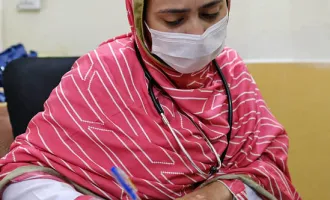
Photo by Clay Banks on Unsplash
This Date in UCSF History: Examining Race’s Impact on Medicine
Originally published in Synapse on October 19, 2006. Friday of Week Four of medical school for the first years: Sitting in class among other coffee junkies, my mind wandered over to how amazing it was that we have learned so much about anatomy, cell biology and body systems in such a short amount of time.
The last lecture that day marched to a different beat however, demonstrating how the school’s curriculum really tries to prepare students to become well-rounded physicians by helping them develop skills such as cultural competence in addition to providing them with a solid knowledge about the molecular basis of disease.
Students had the opportunity to listen to a dynamic talk by Dr. Sandra Moody-Ayers, a staff physician at the VA who spends much of her time as a clinical investigator in health disparities issues, and to an ensuing panel discussion on race and medicine.
What does the term “race” mean? Is it a social construct or is it genetic? How should the issue of race be addressed in the patient encounter?
The purpose of Moody-Ayers’ lecture was not to answer the questions but rather to show that race is a fluid concept that has changed over time; both genetics and social interactions contribute to how we think about race; and that race must not be ignored since there are clearly health disparities that exist between different race and ethnic groups.
She emphasized that we as students and as future healthcare professionals must understand our own culture and background first because we carry them with us into every medical encounter. Should the patient’s race be included in the opening line of an oral or written case presentation? Many of us have probably heard the standard opening of a patient presentation going along the lines of “Mr. Jones is a 64-year-old African American male who complains of x, y, z”.
The UCSF school of medicine currently recommends that race and/or ethnicity not be routinely included in the opening line (or ID section) of the presentation where other standard identifiers (e.g., age and gender) are found, but put in the social history instead.
Moody-Ayers suggested that there is no hard and fast rule, and students will need to learn to use his or her clinical judgment to determine when it’s important to include in the ID, history of present illness, or social history. The panelists of the race discussion,
Dr. Esteban Burchard, Dr. Alicia Fernandez and Dr. Eliseo Perez-Stable, also addressed the above question. Fernandez, an internist at San Francisco General Hospital, emphasized that a patient’s race can sometimes be a proxy piece of clinical information by providing clues about disease probabilities (because certain diseases are more prevalent in some populations than others) while at other times not provide clinically significant information.
All of the physicians stressed the importance of taking a thorough patient history that can guide the students in deciding where information about the patient’s race belongs. When it was time for Q&A, medical students engaged speakers of the panel with several questions that made one thing clear: the topic of race in medicine can be very controversial and there are no easy or quick answers.
Perez-Stable, an internist who also does social, behavioral, and policy sciences research, was asked about the effects of socioeconomic status versus that of race in contributing to health outcomes, and he replied that research has shown that health disparities exist along SES and race divisions and both should continue to be studied in an effort to reduce these disparities. Burchard, who conducts research in biologic and genetic risk factors for diseases, invited students to be thought leaders instead of passive recipients of information, and to actively participate in debates surrounding medicine.
A common theme repeatedly brought up throughout the discussions was that race cannot be ignored. Rene Salazar, a leader of the social/cultural content area of the social behavioral sciences committee of the medical school curriculum, expressed his belief that it is very important that students be exposed to the issue of race and its role in medicine as early as possible in training to give students time to develop skills necessary to address the issue.
When asked what he hopes students could take away from the lecture and the panel discussion, he said, “I hope students walk away with an understanding of how important this issue is. A greater appreciation of the issues at play and the controversy surrounding race will encourage students to think critically about race, its place in medicine, and more importantly its impact on the way we provide care.”



